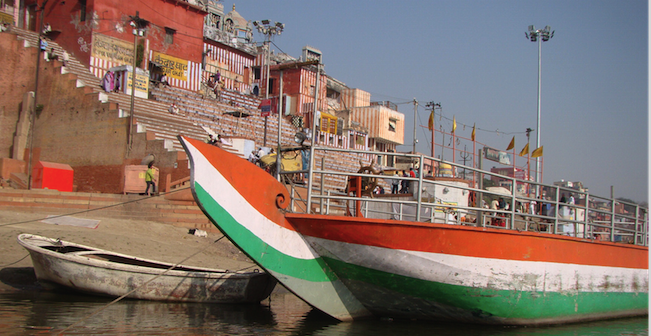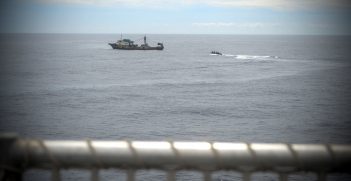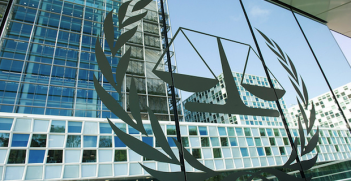India's Monroe Doctrine is Dead

China’s current strategic push in the Indian Ocean is proving difficult for India to resist. India’s most recent Maritime Security Strategy exemplifies its rapidly-changing approach to security in the region.
The trend began in September 2013 when a Chinese nuclear attack submarine first transited the Indian Ocean. What began as part of China’s commitment to the international anti-piracy mission in the Gulf of Aden became the first of many Chinese missions through and within the Indian Ocean. For defence planners within India, these patrols have been interpreted as an attempt not just to normalise Chinese blue ocean naval power but as an attempt to expand its influence within the Indian Ocean.
Like China, India maintains a commitment to nuclear navy and, like China, India has struggled to develop a native defence capability. This means that currently much of the basic capability that will define this space has yet to be constructed. Within this, there is a large amount of space to discuss who is going to maintain primacy within the Indian Ocean. One thing that is not open to debate, however, is that it is India’s strategic policy that is the most vulnerable. This then places an additional layer on the capability debate: that of norms and grand strategy. The latter is generally top down, shaping capability and pushing policy. However an error in grand strategy can be exposed in the shifts in capability, which is currently occurring in India’s case.
The strategic doctrine of India’s first Prime Minister Jawaharlal Nehru was based on the exclusion of great powers within the Indian Ocean. Some analysts have compared this to the Monroe Doctrine of the United States. The Monroe Doctrine sought to exclude European great powers from the American continents. The United States stated that it would view these sorts of intrusions as threatening to its overall security and therefore as an act of aggression.
Similarly, India’s policy has sought to keep the Indian Ocean ‘Indian’. In pursuit of this, India signed a deal with Sri Lanka whereby the latter agreed not to allow great powers to develop a military presence. India also used this doctrine to justify interventions in Sri Lanka and the Maldives in the 1980s. Academics within India have explicitly encouraged Prime Minister Modi to follow this policy.
India’s strategy is now on shaky ground. China has a military base in Africa and it has developed ports throughout the Indian Ocean. Additionally, China has also developed an overland route through Eurasia. While not necessarily a military presence, great powers now routinely operate within the Indian Ocean. Furthermore, as much as India might like to control the strategic choke points in the Straits of Malacca, openly opposing economic expansion and port development by China would bring India into conflict with a range of international norms and existing Indian foreign policies.
Thus capability developments within the region are rendering it impossible to exclude China from the region. Beijing simply has too many points of entry into the system for India to stop it. This is probably due to the terrain itself. Where South America sits geographically separate from Europe, the Indian Ocean is a vital trade route linking China to overseas markets. Concurrent with this China is developing a strong presence in Eurasia. All of these factors pose a strong challenge to India’s narrative around its grand strategy.
The Indian position is also normatively complex. India is a party to the United Nations Convention on the Law of the Sea (UNCLOS) and opposes China’s efforts to restrict freedom of navigation in the South China Sea. This means that any effort to restrict China’s economic and military patrols within the region would bring these commitments into direct conflict. It would also bring India into conflict with the stated policy of the United States on freedom of navigation. As such, India’s potential normative levers for excluding China from the region are very weak.
Successive Indian Prime Ministers have combined efforts to exclude great powers with programs designed to assist in regional integration and peacemaking. Recently India has adjusted this policy, launching the Raisina Dialogue to mimic China’s Shangri-La Dialogue whereby states can have a forum to develop both economic and political ties. The opening of the conference revealed the difficulties India is facing from China, placing them in stark contrast when the President of Sri Lanka called for greater Chinese investment. As such, it is clear that it will be difficult to exclude China even from India’s own regional forums.
Compounding this reality, China’s white paper emphasises both naval development and open seas protection. As such, China is committed to pushing its power into the blue water space regardless of India’s preferences. China’s energy security is dependent upon trade through the Indian Ocean and as such its commitment to freedom of navigation and force protection should be estimated to be quite high. This makes following a Monroe Doctrine in this space almost impossible for India without engaging in a direct bidding war with China for influence along the periphery. This too is a problematic strategy, as China would only need to succeed on one occasion to break the policy and establish a permanent presence.
From this we can see that on a normative and capability level India has little space to continue pushing the exclusion of China from the Indian Ocean or Eurasia. Taken together this means that India’s Monroe Doctrine of excluding great powers from the Indian Ocean is dead. India will have to develop an alternative method of managing China’s power in the region. Analysts must therefore expect India to fall back onto traditional methods of interstate balancing through a commitment to conventional military power and engaging in offshore stabilisation.
Robert Potter is currently a PhD candidate at the University of Queensland. He was previously a research assistant volunteer at the John F Kennedy School of Government, Harvard University. This article is published under a Creative Commons Licence. It may be republished with permission.





